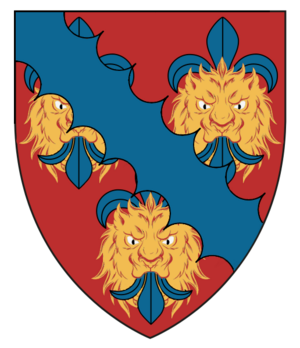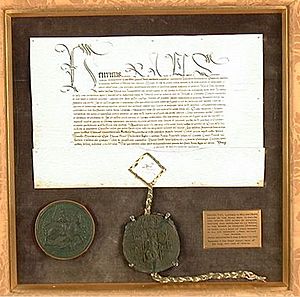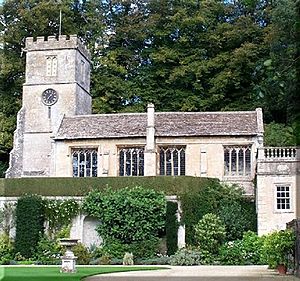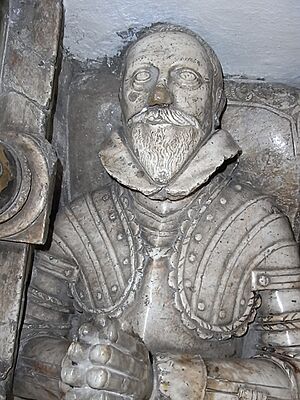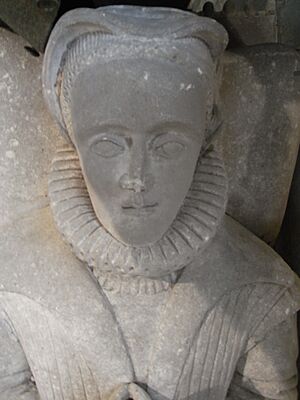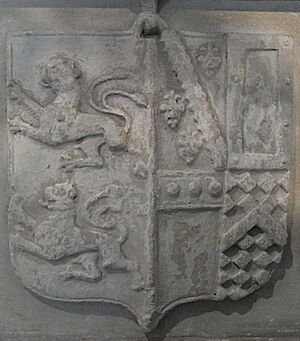William Denys facts for kids
Sir William Denys (around 1470–1533) was an important person in the court of King Henry VIII. He lived in Dyrham, Gloucestershire. He also served as the High Sheriff of Gloucestershire in 1518 and again in 1526. His last name is sometimes spelled Dennis.
Contents
Family Background
William Denys was the oldest son of Sir Walter Denys (who died in 1505). His mother was Agnes Danvers. She was the daughter of Sir Robert Danvers, a Chief Justice. Records from 1505 show that William was about 35 years old then. This means he was likely born around 1470.
First Marriage and Connections
Around 1481, William's father arranged for him to marry Edith Twynyho. Edith's father, John Twynyho (1440–1485), was a rich lawyer and cloth merchant from Cirencester. He was also a Member of Parliament (MP) for Bristol.
John Twynyho worked with John Tame, who built Fairford Church. They grew their sheep, wool, and cloth business. They bought a lot of land for sheep, including Fairford in 1479. John Twynyho's daughter Alice married John Tame. Their tomb can be seen at Fairford Church.
The Twynyho family had connections to powerful people. A relative named Ankaret Twynyho was a servant to Isabel Neville, Duchess of Clarence. The Duchess died in 1476. Her husband, George Plantagenet, Duke of Clarence, wrongly blamed Ankaret for her death. Ankaret was arrested and later executed. However, her conviction was later officially cancelled by the King.
This marriage helped connect the Denys family to the wealthy Twynyho and Tame families.
Career Highlights
Serving the King
William Denys became an Esquire for the Body to the young King Henry VIII. This was an important role, meaning he was close to the King. His half-uncle, Hugh Denys, had been a trusted servant to King Henry VII. It's possible William took his uncle's place after Hugh died in 1511.
Creating a Deer Park
In 1511, King Henry VIII gave William Denys special permission. He could enclose 500 acres of land at Dyrham to create a deer park. This meant he could build a wall or hedge around the land. He could then keep deer there and have exclusive hunting rights.
This special permission is recorded on a parchment document. It has a rare, perfect example of King Henry VIII's Great Seal. This document is now displayed at Dyrham Park. It shows how important William Denys was to the King.
High Sheriff of Gloucestershire
Sir William was chosen as the High Sheriff of Gloucestershire twice. He served in 1518 and again in 1526. The Denys family held this important position more often than any other family in the area.
Second Marriage
Around 1508, William married Anne Berkeley. She was from the powerful Berkeley family of Gloucestershire. This marriage gave William even more status among the local gentry.
Anne's family had faced challenges. Her uncle, William Berkeley, had given his lands to King Henry VII. This meant the Berkeley family lost their ancestral home, Berkeley Castle, for a time. Anne's father, Maurice Berkeley, lived near the Denys family's lands. This closeness might have led to William and Anne's marriage.
Attending the Field of Cloth of Gold
In June 1520, Sir William Denys was chosen for a special event. He was one of about 100 nobles and gentlemen from England who went with King Henry VIII. They traveled to the Field of the Cloth of Gold near Calais, France. There, King Henry VIII met with King Francis I of France.
Each knight had to bring their own group of people. William Denys was later listed as being "With the Queen." This suggests he was part of Queen Katharine of Aragon's group during the event.
Founding the Guild of St. Denis
In 1520, Sir William and Lady Anne started the "Guild of St. Denis." This guild was based at St Peter's Church in Dyrham, next to their home. Guilds were like community groups that helped the poor and needy. They also had a religious purpose.
This guild at Dyrham helped fund priests to sing special prayers for its members. Many people from different towns contributed to the guild. It owned livestock, which it rented out to local farmers for money. The guild was likely named after Saint Denis of Paris, but the Denys family name probably came from their Danish origins.
Children of Sir William Denys
Sir William Denys had one daughter from his first marriage to Edith Twynyho:
- Anne, who died without having children.
With his second wife, Anne Berkeley, Sir William had many children:
Sons
- Sir Walter (died 1571), his oldest son and heir.
- Sir Maurice Denys (died 1563), who was the Treasurer of Calais. He also built Siston Court.
- William II Denys (died after 1571).
- Thomas
- Francis, likely named after King Francis I of France.
- John
Daughters
- Anne, who married twice. She had children from her second marriage to Sir Edward Carne.
- Isabel, who also married twice. Her first husband was Sir John Berkeley (died 1546). Their oldest son was Sir Richard Berkeley, whose statue can be seen in The Gaunts Chapel in Bristol.
- Katherine (died 1560), who married three times. She is buried with her last husband in Fairford Church.
- Eleanor, who married William Lygon. She was the grandmother of Sir Ferdinando Gorges, who founded the American province of Maine.
- Bridget
- Mary, who became a nun. She was the last prioress (leader) of Kington St. Michael Priory. She lived to be very old and was buried at The Gaunts Chapel in Bristol.
- Margaret, who married Sir Nicholas Arnold in 1529. He was an important politician during the Tudor period.
Sources
- Davis, Cecil T., Monumental Brasses of Gloucestershire, London, 1899, p. 109, about the brass of John Twynyho at Lechlade.
- Maclean, Sir John, (ed.), Visitation of the County of Gloucester Taken in the Year 1623 by Henry Chitty, London, 1885. ("Dennis" pp. 49–53)
- Robinson, W.J., West Country Manors, Bristol, 1930. (Dyrham, pp. 73–76; Syston(sic), pp. 169–172)



